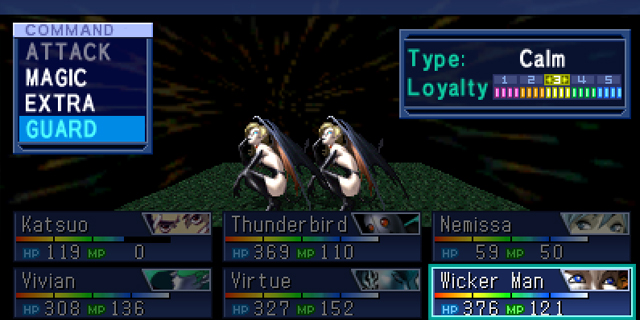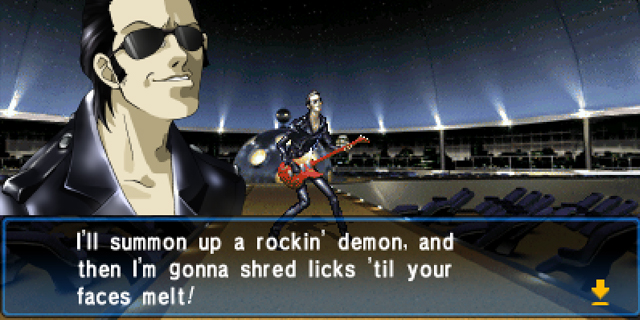
The Shin Megami Tensei series is one of the longest lasting JRPG franchises around, complete with several main games and a slew of popular spin-offs. While these titles have been around since the days of the NES, they never really found their way to North America until the late ’90s and eventually became more recognized with the release of Shin Megami Tensei: Nocturne. Several years (and games) later, Atlus has revived one of the most beloved games in the venerable franchise, Devil Summoner: Soul Hackers, and brought it to an English speaking audience for the first time.
While Soul Hackers probably won’t attract anyone who isn’t already familiar with the Shin Megami Tensei-style of RPG, it does a fine job of reminding those acquainted with its mature brand of role-playing what makes the series so special to begin with.
Taking place in a futuristic, cyberpunk-inspired version of Japan, Soul Hackers follows a group of hackers known as the Spookies. Your nameless hero, one of the members of this assortment of hackers, finds himself uncovering a sinister plot involving an MMO-style game, a government cover-up, and a whole host of demons out for blood. The story isn’t going to offer anything groundbreaking, but it’s a solid tale with a multitude of twists and just enough of that Shin Megami Tensei weirdness to keep you interested from beginning to end. It helps that the cast of characters, while not as fully fleshed-out as you might like, are admirable and turn what could have been a forgettable story into one that keeps you going.

Your handy COMP
You’re equipped with a COMP (or sometimes referred to as a GUMP), which is a gun-shaped handheld computer that allows you to speak with the demons. You can install software to your COMP that allows you to better communicate with demons, make navigating dungeons easier, or, most importantly of all, save your game anywhere. While you can’t change your installed software on the fly, you’ll quickly learn that some of these programs are essential to the game and find a set that works best for your play style. – Andrew Passafiume
The basic gameplay is what you would expect from a dungeon crawler of this nature, complete with a turn-based battle system. You wander around large areas full of treasure, traps and random encounters, complete with a map on the 3DS’ bottom screen that fills out as you explore. The dungeons are plentiful and the areas themselves are excellently-designed, giving you something new with each one you find, but offering enough of the familiar to make sure you’re never completely lost.
There is a fair amount of backtracking, although it never becomes overbearing or tedious. The big problem, however, is the number of enemy encounters there are, which can sometimes make exploration a chore, especially in larger dungeons. This is an older game, designed before JRPGs completely ditched (or otherwise better balanced) random encounters, but sometimes it can be just a little too much to handle. You’ll fall into patterns where you can’t take more than three steps without another random encounter, and in the later dungeons, these battles can get tricky. It’s never a huge issue, but one that comes up just often enough to remind you of how annoying they can be if handled poorly.
Before you play Soul Hackers, just know that this is an old-school dungeon crawler that might be difficult to get into if you’re not prepared. This is certainly a game more welcoming than other titles in the franchise (such as the DS-exclusive Strange Journey), but it doesn’t hold your hand. That being said, the game does a good job of introducing the basics and finding ways to slowly acclimate you to the mechanics. There are also some well-implemented modifiers (such as the ability to lower the difficulty or make the dungeon maps fully accessible from the start) that can help you ease your way into the experience.

What differentiates Soul Hackers (and all Shin Megami Tensei games) from its counterparts are the demons. Any enemy you come across in a random encounter can be talked to instead of fought. Here you can use this as an easy way to get out of battle, get items or, most importantly of all, get them to join your team. You can have up to four demons in your party at once, and when you get far enough into the game, you’ll find yourself with a nice variety of demons that can be mixed and matched to suit your needs depending on the situation. Even after playing several Shin Megami Tensei games with very similar mechanics, it can be refreshing to resolve enemy encounters through conversation instead of conflict.
Each demon has a specific personality as well as a loyalty meter. Their loyalty will go up or down depending on how you use them in combat, which is based entirely on their personalities. For example, one demon that is classified as “wild” will want to focus on physical attacks over magic. The more you command them to use physical attacks, the more their loyalty will go up; once it’s high enough, they will often take hits for you or dodge attacks more easily. If it gets too low, they will refuse to listen to your orders or simply leave your party altogether. The dynamic between keeping a balanced party and making sure all of your demons remain loyal is exciting and offers the sort of challenge you rarely get from JRPGs of this nature.
The other major component of the demon system is the ability to fuse demons to create stronger allies. This is one of the most addictive aspects of the game, giving you ample opportunities to get new demons without relying on random battles to find them. You will be able to preview the creation that will result from the fusion, including the necessary stats of that demon, allowing you to have all of the information you need before proceeding. And once you fuse, the demons you used will be gone (or are purchasable again for a fee), leaving you with your new teammate. As with any Shin Megami Tensei game, I spent far too much time fusing demons or seeing what new demons I could conjure up whenever I had the chance.

Outside of dungeons and demon fusing, you are free to explore the different parts of the city in a small, overview map, which allows you to return to previous locations, shop or simply talk to random pedestrians for basic info. You also have access to Paradigm X, a Second Life-like virtual world that offers most of the game’s side quests and other fun activities (such as a casino that provides rare items as prizes). This presents you a nice change of pace when you need to take a break from exploring dungeons.
Soul Hackers is a brilliant blend of old-school dungeon crawler sensibilities and Shin Megami Tensei-style demon collecting, offering a cool, stylish experience that is both familiar and somewhat refreshing. It might be hard for newcomers to the series (or the genre) to get accustomed to the gameplay, but for series veterans or those just looking for a new RPG for their 3DS will find plenty to like about this excellent update.
Pros: Intriguing story with great characters, well-designed dungeons, demon fusing is addictive
Cons: Frequent random encounters can be troublesome at times



















